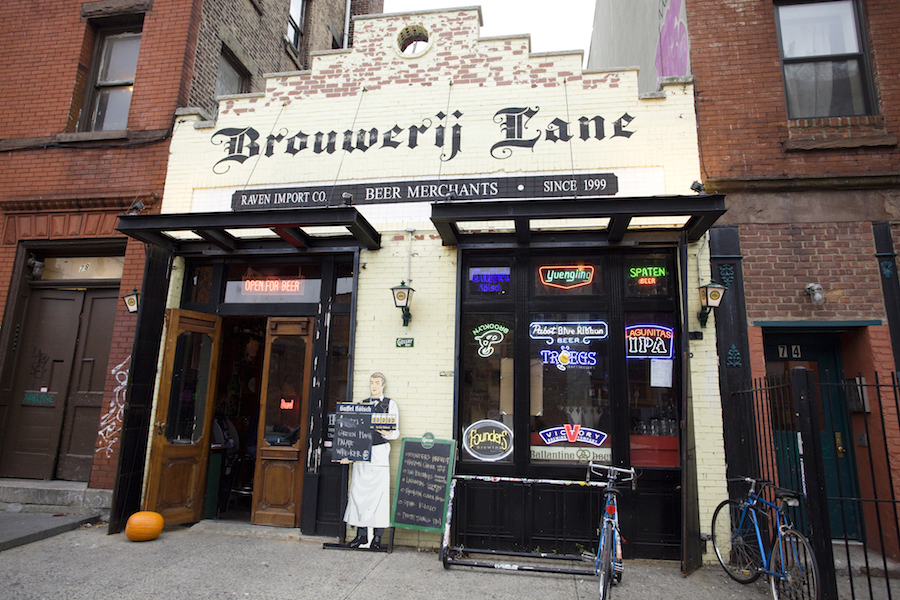Feeling nostalgic for a simpler time? Looking for an excuse to don your tricorn hat? There’s no need to head for Fraunces Tavern when the colonial mood strikes: Several Brooklyn eateries invoke pre-Revolutionary geography and obscure historical landmarks in their names, if not always in their cuisine. While the results are equal parts factual and fanciful, they all conjure up the stories of bygone Brooklyn.
Although this beer shop doesn’t make the suds on its shelves, it takes its name from the Dutch word for brewery. And while the building’s stepped-gable facade and Gothic signage recall Brooklyn’s Dutch past, that name, like the store’s eclectic list of beers on draft, is a bit of a hybrid concept. Greenpoint was settled by Scandinavians and Huguenots, not by the Dutch (who granted these settlers the land between the Newtown Creek and Bushwick inlet). And to colonial Greenpointers, Bouwerij Lane was the name of the road across the river that led to Peter Stuyvesant’s verdant homestead in the present-day east Village, near the thoroughfare now spelled Bowery. Still, the olden-times appeal of standing in front of Brouwerij Lane’s Dutch Revival facade, swinging a growler and gazing down Greenpoint Avenue to the East River is not to be underestimated. If you look carefully—and drink heartily—you can see the ghost of an 18th-century skiff pulling up to the shore.
Diners waiting for one of Buttermilk Channel’s busy tables can learn about the restaurant’s name from a series of vintage-style postcards on a rack by the door. The restaurant was christened for the mile-long tidal strait that separates Brooklyn from Governors Island. Brooklyn dairy farmers used to row across the strait en route to Manhattan, where they sold their milk in the markets that dotted the downtown piers; some say the channel crossing was so rough that the pitching waves churned the milk to butter before the farmers could reach the other side. In a series of “Brooklyniana” articles for the Brooklyn Eagle, Walt Whitman popularized the idea that before the channel was dredged to accommodate larger ships, cows could even walk across at low tide. His suggestion is confirmed by the work of an earlier chronicler of New York, Washington Irving, whose fictional historian Diedrich Knickerbocker insisted that during the “Golden Age” of New Amsterdam, “Buttermilk Channel was quite dry at low water . . . [and] the shad in the Hudson were all salmon.” These days, neither claim is true, but you can get buttermilk fried chicken and baked oysters at Buttermilk Channel, a straight shot (as the crow flies, if not as the cow swims) east of its namesake strait.
Fort Defiance café and bar is situated ever nearer to the exact location of its namesake: it honors the memory of a five-gun redoubt, or temporary fort, built during the Battle of Brooklyn on the orders of General George Washington, and located near the contemporary Beard Street. At that time the area was a large hill, adjacent to the Upper New York Bay, and thus an excellent perch from which to shoot at British Admiral William Howe’s man-o-war, Roebuck, and keep the Redcoat fleet out of the East River. While the British ultimately won the 1776 Battle of Brooklyn, Fort Defiance is credited with confounding the enemy long enough to allow the American troops to evacuate to Manhattan in safety.
While the modern-day eatery, just two blocks away from the original fort, pays tribute to its American heritage with menu items like Plymouth Rock chicken and pimento cheese, its cocktail list, curated by owner St. John Frizell and featuring a Colonial Cooler and a Barbados Buck, suggests a Tory influence. Perhaps these are offerings to appease Red Hook’s Redcoat ghosts: the remains of three British soldiers from that battle are reportedly buried at Columbia and Nelson Streets, on the other side of Red Hook Park.
Spuyten Duyvil Creek is far from Spuyten Duyvil, the brewpub (and its sister biz, an eclectic grocery a few blocks away). The creek connects the Hudson River to the Harlem River, separating Manhattan from the Bronx and thus from mainland America. The creek’s name (which has also become the name of the adjoining Bronx neighborhood), is Dutch—but whether it should be translated as “devil’s spout,” “devil’s whirlpool” or “in spite of the devil” remains an open question. The latter was put forth by Washington Irving, who once again insinuated himself into Gotham mythology with a tale of a New Amsterdam trumpeter who was drowned in the creek by the devil himself and fated to walk the banks of Inwood Hill Park for all time.
Here in Brooklyn, the Spuyten Duyvil bar and its companion grocery (inside the Williamsburg Mini-Mall) might consider all of the Dutch phrase’s translations appropriate to their cause: with a menu of “rare and obscure” beers on tap, it could be both the devil’s spout and his whirlpool, although guests are unlikely to drown more than their cares and sorrows at the gleaming mahogany bar.
Of course, if these historical haunts are too specific for your taste, there’s always the recent Cobble Hill arrival, Breukelen, whose name channels the entire County of Kings, and whose decor includes two original truing cables from the building of the Brooklyn Bridge. These artifacts remind pilgrims from Manhattan that without John A. Roebling’s marvelous technology, they might still need to take a boat to sample Brooklyn’s culinary delights.



